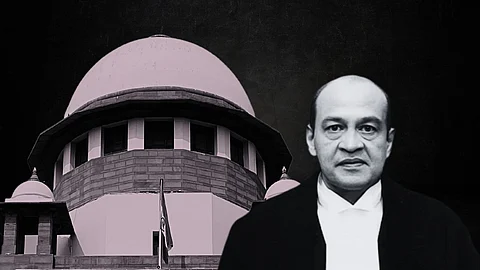

THE SUPREME COURT TODAY reserved its judgment on the plea by Justice Yashwant Varma—a sitting judge of the Allahabad High Court—seeking the quashing of the in-house committee’s report and the May 8 communication from the then Chief Justice of India, Justice Sanjiv Khanna, to the President Droupadi Murmu and the Prime Minister Narendra Modi, recommending his removal over the alleged recovery of a large sum of unaccounted cash from his official residence in Delhi.
During the hearing, Justice Dipankar Datta, heading the bench also comprising Justice Augustine George Masih, remarked that “Your conduct does not inspire confidence,” signalling scepticism toward Justice Varma’s challenge.
The Bench drew a distinction between the Chief Justice’s recommendation for removal and the actual process of removal itself, emphasising that the Chief Justice is not merely a conduit. “He is not a post office. If the Chief Justice has material indicating misconduct, he has a duty towards the nation to inform the President and Prime Minister,” Justice Datta remarked.
In the course of the hearing, there were hints that the Court might not interfere in the matter as the removal of Justice Varma is under consideration of the Parliament.
Senior Advocate Kapil Sibal, appearing for Justice Verma, argued that the in-house mechanism created in 1999 was never intended to substitute the formal constitutional process for removal under Article 124(5) and the Judges (Inquiry) Act, 1968. He contended that the former CJI’s communication bypassed established statutory procedure and that the confidential tapes and committee report were improperly made public and leaked to the media.
However, the Bench was not persuaded. It noted that if there were procedural lapses, they would not undermine the powers of Parliament, which was already seized of the matter through a removal motion initiated after the former CJI’s recommendation. “The points you are raising now are major. But you did not raise them earlier. Instead, you participated in the proceedings, and now that the findings are unpalatable, you are questioning the process,” the Bench told Sibal.
The Court also referred to the Judges (Protection) Act, 1985, stating that Section 3(2) of the Act provides an answer to the petitioner’s arguments. “You should have assisted us on the Judges Protection Act. Law is there. This provision answers your submissions,” Justice Datta observed.
Section 3(2) of the Judges (Protection) Act, 1985 says, “(2) Nothing in sub-section (1) shall debar or affect in any manner the power of the Central Government or the State Government or the Supreme Court of India or any High Court or any other authority under any law for the time being in force to take such action (whether by way of civil, criminal, or departmental proceedings or otherwise) against any person who is or was a Judge.”
The Bench questioned why Justice Varma had not objected to the constitution of the committee at the outset if he believed it to be unconstitutional. “You appeared before the committee hoping to be exonerated. Now that the report is adverse, you find it unpalatable,” the Bench said.
In the course of the hearing that lasted over an hour there were enough indications that the Supreme Court is unlikely to interfere in the matter as parliament is already seized of the matter on a motion initiated by the Union government in the wake of then CJI’s May 8 communication recommending the removal of Justice Varma.
Pointing to the flaws in the procedure being followed for the removal of Justice Varma, Sibal argued that the motion for the removal of a sitting judge can only be moved by a motion signed by 100 Lok Sabha members if it is before the lower house or 50 members of Rajya Sabha, if it is before the Upper house. He said that the government is nowhere in this process, as is happening now.
He said that no Member of Parliament is going to say anything after the May 8 communication of the then CJI Khanna recommending Justice Varma’s removal. “Do you know what kind of comments are being made against me in Parliament by even ministers, when Parliament was in session?”, Sibal asked the bench.
When Sibal pointed out that both the inquiry committee report and the tapes which were mandated to be kept confidential were made public and leaked respectively, the bench said, “If there was some lapse in the observance (of procedure), the same cannot not curtail the powers of the Parliament. The probe committee set up by the parliament will have members of imminence and they cannot be influenced.”
Justice Varma’s plea contends that no formal complaint preceded the probe and that the in-house committee violated principles of natural justice—failing to notify him of the procedure, denying access to critical evidence such as CCTV footage, and drawing adverse inferences without clearly establishing the ownership or quantity of the recovered cash.
The case stems from a fire incident on March 14 at Justice Verma’s then-official residence on Tughlaq Road. Delhi Fire Service personnel reportedly discovered bundles of semi-burnt cash in a storeroom while extinguishing the fire. The video of the burning cash went viral, triggering allegations of corruption and prompting the Supreme Court to issue a press release.
Following the incident, then Chief Justice of India Sanjiv Khanna constituted a three-member in-house panel on March 22, comprising Chief Justices Sheel Nagu (Punjab & Haryana), GS Sandhawalia (Himachal Pradesh), and Justice Anu Sivaraman (Karnataka) High Courts. The committee submitted its report on May 3, and on May 8, CJI Khanna wrote to the President and Prime Minister recommending Justice Verma’s removal.
The Supreme Court, having heard detailed arguments, has now reserved its verdict. Meanwhile, the matter is also under consideration in Parliament, which is the only authority empowered to act upon a recommendation for a judge’s removal.